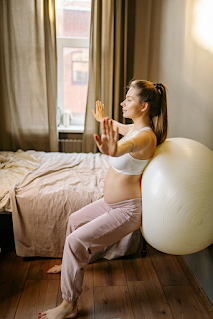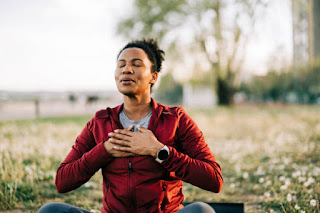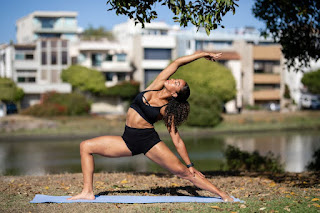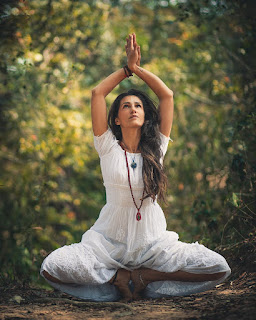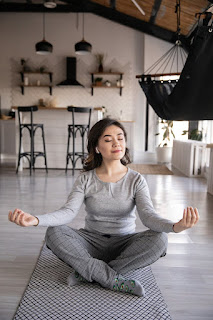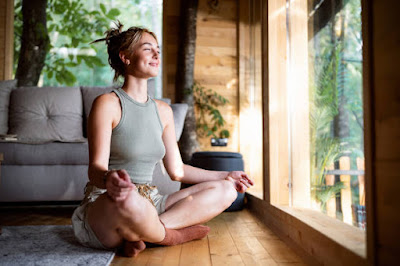Restorative Yoga for Pregnancy: Relaxation and Stress Relief
Pregnancy can be physically demanding and emotionally stressful. Restorative yoga offers a gentle, supportive practice to help expectant mothers relax and ease tension. It emphasizes slow, passive poses held with the help of props (bolsters, blankets, blocks, even exercise balls) so the body can fully release and rest. Unlike active styles of yoga (e.g. Vinyasa or hot yoga), restorative classes move slowly and hold each pose for several minutes, fostering deep calm and activating the body’s “rest and digest” response. As one prenatal yoga guide notes, quiet restorative poses give a mother “time to be with her baby, listen to her baby and to her own body” promoting both physical ease and mindful connection.
What Is Restorative Yoga?
Restorative yoga is a gentle, relaxation-focused practice. It uses props (bolsters, blankets, straps) to fully support your body in each posture. Instead of flowing quickly through many poses, restorative yoga moves at a slow pace, holding only a few postures at a time for 3–5 minutes or more. This passive approach helps shut off the stress response: deep breathing and stillness in supported poses activate the parasympathetic nervous system. In a restorative class you might lie reclined with props under your back and limbs, or sit with support under your hips to keep the spine long. These supports allow even beginners and pregnant women to relax fully. For example, simple props like an exercise (stability) ball (pictured) can help support the body in gentle stretches. In the photo below, a pregnant woman uses a ball behind her back to keep the spine comfortable while she breathes and moves slowly. These kinds of supports make it easier to hold each pose longer without effort.
Using props like an exercise ball can help support the body in restful poses. For example, a pregnancy ball (pictured) can support your back or hips while you stretch gently, allowing you to hold poses longer without strain. This sort of support – bolsters under your spine, blocks under your knees or head, blankets under ankles or knees – is a hallmark of restorative yoga. By leaning into the props rather than engaging muscles actively, you encourage your body to release tension, slow the heart rate, and lower blood pressure. Over time, the mind and body settle into a state of deep rest.
Benefits During Pregnancy
Restorative yoga can offer many pregnancy-specific benefits, especially around stress relief, relaxation, sleep, and comfort:
- Reduces stress and anxiety. Gentle, supported stretching and deep breathing help quiet the nervous system. Yoga in general has been linked to lower stress hormones (like cortisol) and reduced anxiety. Practicing prenatal restorative yoga encourages mindfulness and calm, which can ease pregnancy jitters. In fact, research shows prenatal yoga programs significantly reduce anxiety levels in expectant mothers.
- Improves sleep and energy. Many pregnant women struggle with insomnia or fragmented sleep. Regular restorative yoga can help improve sleep quality. Studies find that adding yoga into a daily routine “may help boost the quality of your sleep”, and prenatal yoga in particular has been shown to alleviate fatigue and make mothers feel more rested. Better rest can leave you feeling more energized and balanced during the day.
- Relieves back and body discomfort. As pregnancy advances, aches and pains (especially in the lower back, hips, and legs) often increase. Restorative poses gently open tight areas and improve circulation without strain. For example, supported reclined hip-openers and wide-child poses can ease lower-back tension. The Mayo Clinic notes prenatal yoga “decrease[s] lower back pain” and other discomforts. Likewise, elevating the legs (as in Legs-Up-The-Wall) or side-lying rests can reduce swelling and soothe tired hips and feet. In supported postures, muscles and joints relax gradually, which can diminish stiffness and discomfort.
- Calms the mind and strengthens connection. Holding quiet poses and focusing on breath gives you space to connect with your changing body and baby. As one prenatal yoga source explains, restorative practice offers “quiet time with baby” to develop awareness and understanding of your inner thoughts. This mindful bonding can enhance emotional well-being. Overall, prenatal yoga has been associated with improved mood and a sense of well-being. The deep relaxation can also lower the incidence of pregnancy-related headaches and reduce hypertension risk.
Each of these benefits – less stress and anxiety, better sleep, and reduced pain – helps make pregnancy more comfortable and supports a healthier mind-body state for both mother and baby.

Safe Restorative Yoga Poses for Pregnancy
Below are several calming restorative poses that are generally safe in pregnancy. In every pose, use plenty of props (bolsters, blankets, blocks) to support your body and modify as needed. Always listen to your body and the stage of your pregnancy: if something hurts or feels uncomfortable, ease back or skip it.
- Supported Reclining Bound Angle (Supta Baddha Konasana): Sit with your pelvis against a bolster or stack of blankets set at about a 30–45° incline. With the bolster under your shoulders/back, lie back and bring the soles of your feet together, knees wide apart. Place blankets or pillows under each knee (or rolled blankets under both ankles) to support the thighs. You can also slide one or two blankets under your forearms for added support under the chest. This position gently opens the hips and stretches the inner thighs while keeping your spine supported. (As your belly grows, you may need more padding under your back or between your legs; support under the head is especially important.) Keep your lower back lightly pressed into the bolster so you don’t over-arch. Breathe slowly here for several minutes.
- Supported Wide-Knee Child’s Pose (Balasana): Kneel on the floor and spread your knees wide apart (to accommodate your belly), keeping big toes together. Sit back on your heels (or on a cushion or folded blanket if needed). Place a bolster or firm cushion on your thighs and rest your torso and chest over it. You may lower your forehead onto a block, pillow, or another blanket. You can also extend your arms forward, resting forearms on more blankets, or alongside your body. This deeply restorative version of Child’s Pose gently stretches the back and hips while taking pressure off the lower spine. Adjust the distance between your buttocks and heels (or use pillows under your hips) so there’s no strain on knees. Stay here for a few minutes, breathing deeply.
- Legs-Up-The-Wall (Viparita Karani), Supported: Sit with one hip against a wall and lie down on your back as you swing your legs up vertically against the wall. Slide a folded blanket or bolster under your hips so that your pelvis and lower back are slightly elevated (this angle helps avoid lying completely flat). Allow your arms to rest at your sides, palms up. Keep your head on a small pillow if needed. This inversion helps drain fluid from the legs, reducing swelling or tiredness in your feet and ankles. (If lying on your back causes dizziness or discomfort, try a half Legs-Up by coming into a supported side-lying position: lie on your side with one leg extended up the wall and the other bent, supporting the raised leg on pillows.) Always come out of this pose slowly.
- Side-Lying Relaxation (Modified Savasana): In later pregnancy, fully lying on the back may feel uncomfortable or is sometimes discouraged. As a deeply restful alternative, lie on your left side with knees slightly bent. Place a pillow or block between your thighs, and one or two under your belly for support, and another to cushion your head. Stretch your arms comfortably (one supporting your head or stacked under a pillow). This side-lying savasana allows full relaxation without compressing the vena cava (a large abdominal vein). Stay here for 5–10 minutes, breathing gently, to absorb the benefits of your practice. (After resting, you can switch sides briefly, though lying on the left side is often recommended for optimal blood flow.)
- Cat–Cow Stretch (Marjaryasana–Bitilasana): Begin on hands and knees (tabletop position). Place blocks under the hands if wrists are sensitive. Inhale and lift your tailbone and chest (cow), keeping your belly low; exhale and tuck your chin and round your spine (cat). Move slowly between these two, syncing with your breath, for 1–2 minutes. This gentle dynamic stretch warms up and lubricates the spine, relieving stiffness in the back and neck without deep twisting. It’s a safe, grounding movement for all trimesters.
- Easy Seated Pose (Sukhasana) with Support: Sit cross-legged on a folded blanket or bolster so that your hips are higher than your knees. Allow the knees to fall out to the sides, supporting them with blocks or rolled blankets if needed. Keep your spine tall and chest open. Rest your hands on your belly or knees, and breathe softly. This simple seated pose promotes calm awareness and good posture. Even sitting quietly in Sukhasana for a few minutes can be very restorative. If sitting cross-legged is uncomfortable, try any gentle seated forward bend (with lots of support under the torso) or a supported kneeling position.
Each of these poses can be held for several minutes (in a quiet, mindful way) or repeated as needed. Use extra blankets or bolsters under sore spots (ankles, knees, hips) for more comfort. The goal is to feel completely supported so your muscles can soften and you can breathe into your stretch, rather than ‘working’ the posture.
Sample Restorative Yoga Flow for Pregnancy
Below is a brief example sequence you might follow at home. Take your time moving between poses and pause if you feel any discomfort. Hold each pose with steady breaths for 3–5 minutes (or longer if you wish) before moving to the next.
- Centering & Breath: Begin seated (on a cushion or bolster) in a comfortable cross-legged or kneeling position. Close your eyes, rest your hands on your belly, and take slow, deep breaths in and out through the nose for 1–2 minutes. This calms the mind and connects you with your breath.
- Gentle Cat–Cow: Come to hands-and-knees (tabletop). On an inhale, drop your belly toward the floor and lift your chest (Cow Pose); on an exhale, round your spine and tuck your chin (Cat Pose). Flow slowly between these for 6–8 breaths to loosen the spine.
- Supported Child’s Pose: From tabletop, sit back into a wide-kneed Child’s Pose with a bolster under your torso (as described above). Stretch your arms forward or rest them by your sides and allow your chest to rest on the support. Relax here, breathing deeply, for 3–5 minutes.
- Supported Reclined Bound Angle (Supta Baddha): Carefully sit up and reposition bolsters/blankets behind you into a reclined position (as described above). Lie back so your shoulders and head are supported, bring soles of feet together, and place cushions under knees. Rest your arms on the floor or on pillows. Close your eyes and soften all muscles, staying here for 3–5 minutes as you breathe.
- Legs-Up The Wall (Supported): Slide sideways off the bolster and scoot closer to the wall so you can swing your legs up. Lie on your back and lift your legs up the wall, with a blanket or bolster under your hips for slight incline. Arms rest at your sides, palms up. Stay here for 3–5 minutes, feeling blood flow away from your legs.
- Final Relaxation – Side-Lying Savasana: After the inversion, slowly roll onto your left side into a comfortable resting position (as described earlier). Stack pillows between your knees and under your head. Rest quietly on your side for 5–10 minutes, focusing on gentle breathing and complete relaxation. (Note: A healthline guide calls Side-Lying Corpse Pose “restorative” and says it “relieves fatigue and enhances relaxation”).
Afterward, come back up to a seated position slowly, and take a few more mindful breaths. Drink some water and move gently as needed before continuing your day. This short flow can help you unwind and reconnect with your body. Feel free to repeat any pose as needed or shorten/lengthen holds according to your comfort.

Safety and Precautions
Safety is paramount during pregnancy. Keep these guidelines in mind each time you practice restorative yoga:
- Consult Your Healthcare Provider: Before starting any prenatal exercise, get your doctor’s or midwife’s approval. If you have a high-risk pregnancy or medical concerns (e.g. placenta previa, preterm labor risk, heart conditions), some poses might be contraindicated. Always follow your provider’s advice about exercise.
- Choose Pregnancy-Safe Classes: Look for prenatal or gentle yoga classes specifically. Certified prenatal instructors can offer appropriate modifications. Avoid any yoga style that is too intense – for example, hot yoga (heated Bikram classes) is not recommended during pregnancy. Stick to hatha, prenatal, or restorative formats as advised by health authorities.
- Avoid Overheating and Stay Hydrated: Practice in a well-ventilated, comfortably cool room. Wear loose, breathable clothing and keep water nearby. Pregnancy naturally raises your core temperature, so listen to your body and skip any poses or conditions that make you feel overheated or faint.
- Mind Your Spine and Belly: After the first trimester, avoid lying fully flat on your back for long periods. The weight of the uterus can compress the vena cava and reduce blood flow. In reclining poses, always elevate your upper body (with bolsters) or perform them on your side (as described above) to stay safe. Similarly, avoid deep or forceful twists that press into the belly. Keep twists gentle, focusing on turning from the upper back only.
- Use Props and Modifications Generously: Prop up your torso, head and limbs as needed so that no pose feels intense. For example, put blankets under knees in Forward Folds, or use a chair for support in standing poses. If you feel any pinching, dizziness or strain, stop or adjust the pose. Never hold your breath: breathe slowly and continuously. As Mayo Clinic advises, if you can’t speak comfortably during an exercise, you’re probably pushing too hard.
- Listen to Your Body: Pregnancy changes day-to-day. Some days you may have more energy; other days you may feel tired or lightheaded. Honor those signals. If a pose suddenly feels wrong or painful, gently come out of it. Rest whenever needed. A useful rule is to avoid stretching “to the point of pain”. Pregnancy hormones (like relaxin) increase flexibility, which can raise injury risk if you over-stretch. Move only as far as feels easy.
- Watch for Red Flags: Stop your practice and consult your doctor if you experience any concerning symptoms: vaginal bleeding or fluid leakage, regular contractions or cramping, severe dizziness, headache, chest pain, shortness of breath beyond normal, or calf pain/swelling. Even if a symptom occurs only during yoga or right after, report it and get medical advice before continuing.
By practicing thoughtfully and making modifications, restorative yoga can be very safe in pregnancy. But always err on the side of caution – it’s better to skip or adjust a pose than to risk strain. A qualified prenatal instructor can also guide you on safe variations as your pregnancy progresses.
Differing Opinions on Supine and Inversion Poses
Medical vs. Traditional Guidance: There is some debate about certain poses in prenatal yoga. Historically, many prenatal care guidelines (including ACOG and others) have advised avoiding supine (lying flat on your back) after mid-pregnancy due to concerns about vena cava compression. By this advice, even modified back-lying poses were limited, especially past 20–24 weeks. Many instructors therefore recommend side-lying or upright alternatives (like supported bound-angle or side-lying savasana) instead of full back bends.
On the other hand, experienced prenatal yoga teachers note that gentle, supported inversions can still be beneficial. For instance, “legs up the wall” (Viparita Karani) with the torso inclined is used in some traditions because it can improve circulation and reduce swelling. Some teachers cite Iyengar yoga’s recommendation of inversions during pregnancy for circulatory benefits. The key is moderation and support: a fully flat bridge or headstand is never advised, but raising the legs with props can be okay for many women if they feel comfortable.
Consult Your Provider: Because opinions vary and every pregnancy is different, decisions about supine or inversion poses should be made in consultation with your healthcare provider and a prenatal yoga expert. Always prefer caution: if your doctor advises against any back-lying posture, listen to them. Likewise, only attempt gentle inversions if you have a stable practice and feel fine doing them (and don’t try anything new or challenging without professional guidance).
In summary, the safest approach is to tune in to your body and follow medical guidance. Use props and variations (e.g. incline your torso, keep legs supported on a chair, or lie on your side) so that you stay comfortable. Above all, take the conservative option if you’re unsure – you can still gain deep relaxation from poses that don’t aggravate the vena cava or overwhelm you.
Legal Disclaimer
Disclaimer: This article is for informational purposes only and is not a substitute for medical advice. Always consult your healthcare provider before beginning any exercise program during pregnancy. Performing any of the above yoga poses or sequences is entirely at your own risk. Neither the author nor publisher accepts any responsibility for injury, loss, or damage incurred as a result of your use of the information or practices in this article.
Should you have any medical concerns or uncertainties, check with your doctor or a certified prenatal yoga instructor before proceeding with yoga practice.
